NRSG367 Semester 2 2019: Reflection on NSQHS Standards in Nursing
VerifiedAdded on 2022/09/23
|9
|1789
|50
Report
AI Summary
This report is a reflective analysis of two incidents encountered by the student while working as a registered nurse, using the Gibbs Reflective Model to examine experiences and relate them to the National Safety and Quality Health Service (NSQHS) standards. The first incident involves a patient suffering adverse effects from medication due to a lack of a comprehensive care plan and inadequate documentation, highlighting the importance of screening tests and clear communication. The second incident describes a failure in communication with a patient regarding allergies, leading to a deterioration of the patient's condition. Both incidents are analyzed in the context of NSQHS standards, particularly comprehensive care and communication for safety. The reflection emphasizes the significance of documentation, effective communication, and the development of holistic care plans to enhance patient safety and improve nursing practice. The student concludes with an action plan to improve future practice by prioritizing documentation and communication.
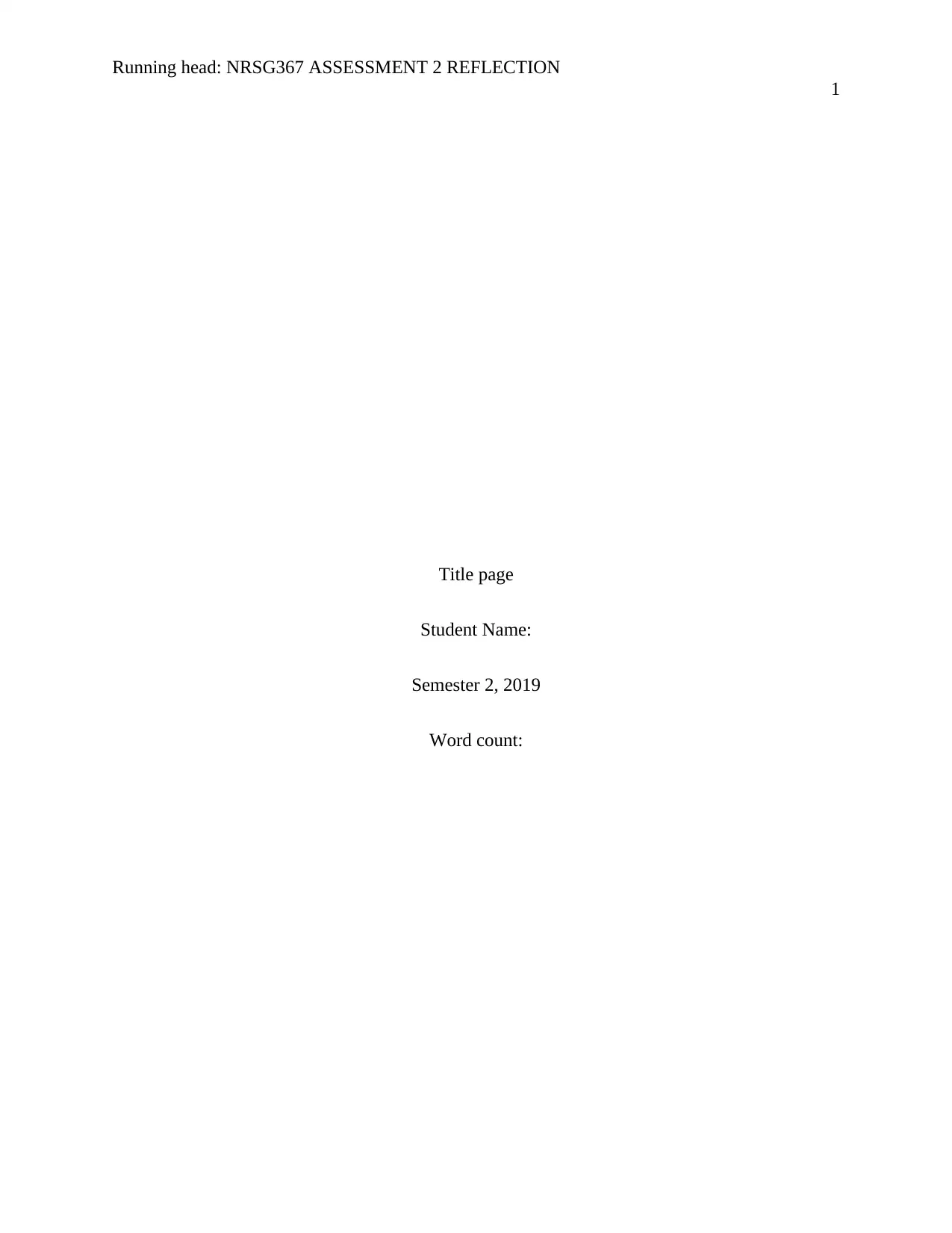
Running head: NRSG367 ASSESSMENT 2 REFLECTION
1
Title page
Student Name:
Semester 2, 2019
Word count:
1
Title page
Student Name:
Semester 2, 2019
Word count:
Paraphrase This Document
Need a fresh take? Get an instant paraphrase of this document with our AI Paraphraser
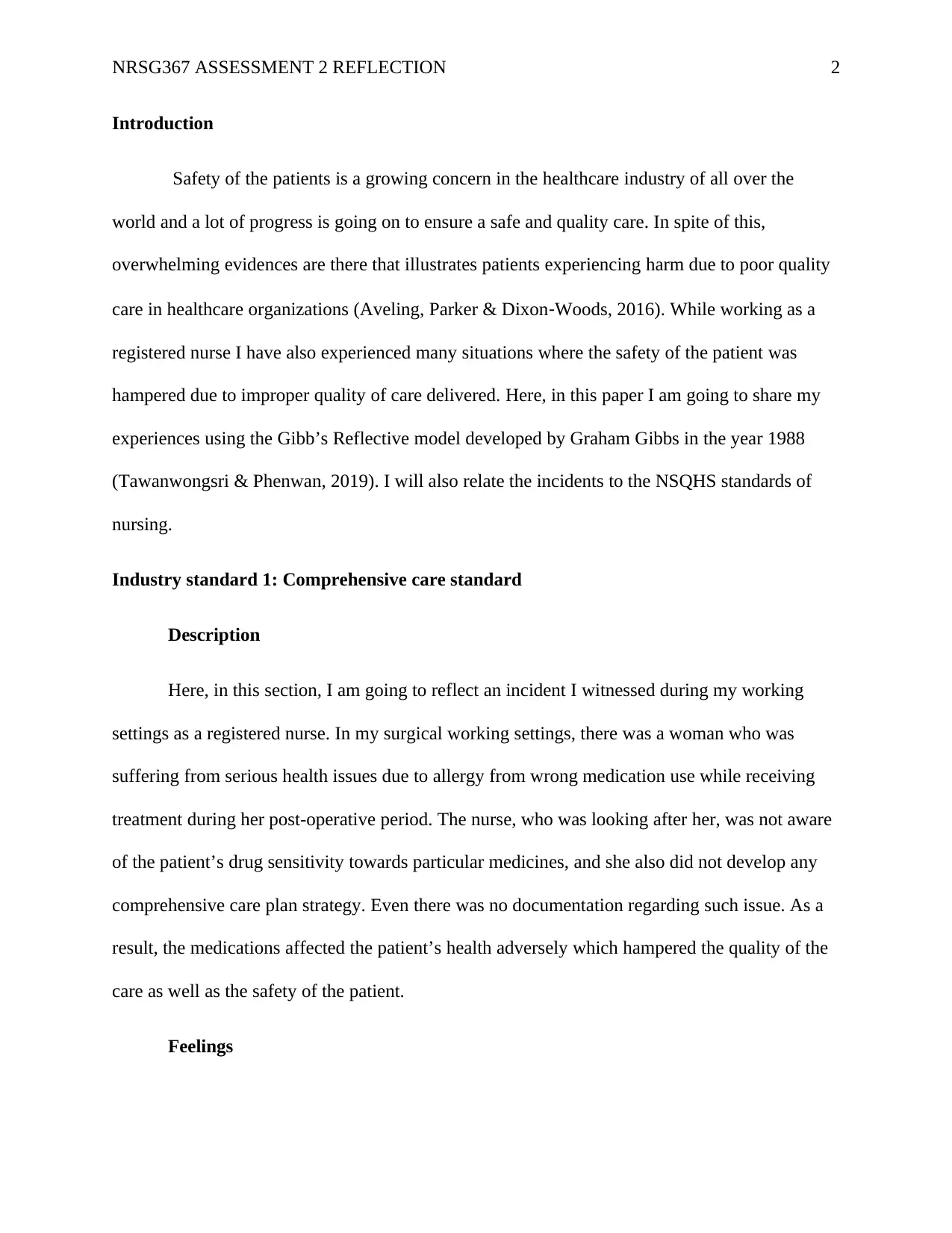
NRSG367 ASSESSMENT 2 REFLECTION 2
Introduction
Safety of the patients is a growing concern in the healthcare industry of all over the
world and a lot of progress is going on to ensure a safe and quality care. In spite of this,
overwhelming evidences are there that illustrates patients experiencing harm due to poor quality
care in healthcare organizations (Aveling, Parker & Dixon‐Woods, 2016). While working as a
registered nurse I have also experienced many situations where the safety of the patient was
hampered due to improper quality of care delivered. Here, in this paper I am going to share my
experiences using the Gibb’s Reflective model developed by Graham Gibbs in the year 1988
(Tawanwongsri & Phenwan, 2019). I will also relate the incidents to the NSQHS standards of
nursing.
Industry standard 1: Comprehensive care standard
Description
Here, in this section, I am going to reflect an incident I witnessed during my working
settings as a registered nurse. In my surgical working settings, there was a woman who was
suffering from serious health issues due to allergy from wrong medication use while receiving
treatment during her post-operative period. The nurse, who was looking after her, was not aware
of the patient’s drug sensitivity towards particular medicines, and she also did not develop any
comprehensive care plan strategy. Even there was no documentation regarding such issue. As a
result, the medications affected the patient’s health adversely which hampered the quality of the
care as well as the safety of the patient.
Feelings
Introduction
Safety of the patients is a growing concern in the healthcare industry of all over the
world and a lot of progress is going on to ensure a safe and quality care. In spite of this,
overwhelming evidences are there that illustrates patients experiencing harm due to poor quality
care in healthcare organizations (Aveling, Parker & Dixon‐Woods, 2016). While working as a
registered nurse I have also experienced many situations where the safety of the patient was
hampered due to improper quality of care delivered. Here, in this paper I am going to share my
experiences using the Gibb’s Reflective model developed by Graham Gibbs in the year 1988
(Tawanwongsri & Phenwan, 2019). I will also relate the incidents to the NSQHS standards of
nursing.
Industry standard 1: Comprehensive care standard
Description
Here, in this section, I am going to reflect an incident I witnessed during my working
settings as a registered nurse. In my surgical working settings, there was a woman who was
suffering from serious health issues due to allergy from wrong medication use while receiving
treatment during her post-operative period. The nurse, who was looking after her, was not aware
of the patient’s drug sensitivity towards particular medicines, and she also did not develop any
comprehensive care plan strategy. Even there was no documentation regarding such issue. As a
result, the medications affected the patient’s health adversely which hampered the quality of the
care as well as the safety of the patient.
Feelings
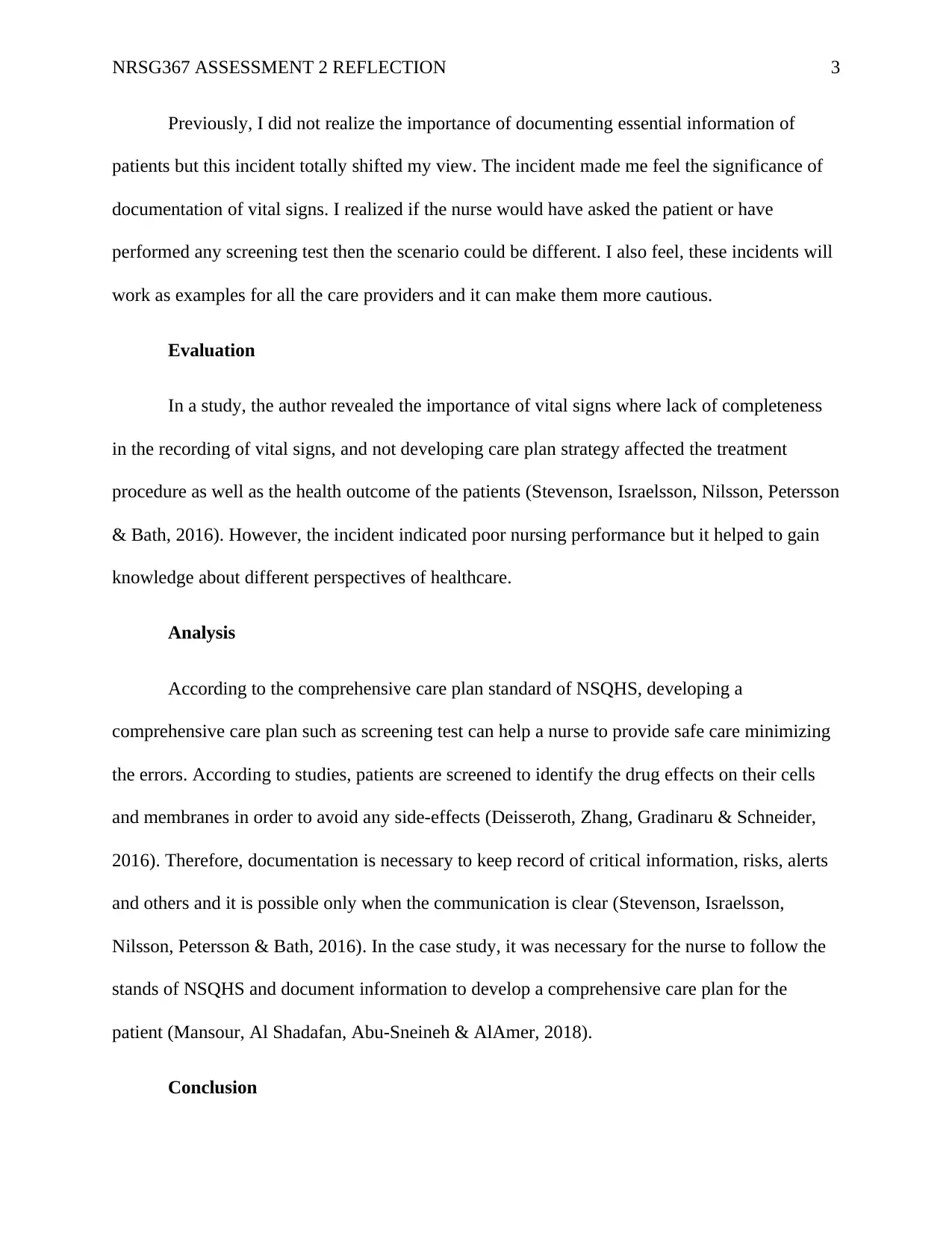
NRSG367 ASSESSMENT 2 REFLECTION 3
Previously, I did not realize the importance of documenting essential information of
patients but this incident totally shifted my view. The incident made me feel the significance of
documentation of vital signs. I realized if the nurse would have asked the patient or have
performed any screening test then the scenario could be different. I also feel, these incidents will
work as examples for all the care providers and it can make them more cautious.
Evaluation
In a study, the author revealed the importance of vital signs where lack of completeness
in the recording of vital signs, and not developing care plan strategy affected the treatment
procedure as well as the health outcome of the patients (Stevenson, Israelsson, Nilsson, Petersson
& Bath, 2016). However, the incident indicated poor nursing performance but it helped to gain
knowledge about different perspectives of healthcare.
Analysis
According to the comprehensive care plan standard of NSQHS, developing a
comprehensive care plan such as screening test can help a nurse to provide safe care minimizing
the errors. According to studies, patients are screened to identify the drug effects on their cells
and membranes in order to avoid any side-effects (Deisseroth, Zhang, Gradinaru & Schneider,
2016). Therefore, documentation is necessary to keep record of critical information, risks, alerts
and others and it is possible only when the communication is clear (Stevenson, Israelsson,
Nilsson, Petersson & Bath, 2016). In the case study, it was necessary for the nurse to follow the
stands of NSQHS and document information to develop a comprehensive care plan for the
patient (Mansour, Al Shadafan, Abu-Sneineh & AlAmer, 2018).
Conclusion
Previously, I did not realize the importance of documenting essential information of
patients but this incident totally shifted my view. The incident made me feel the significance of
documentation of vital signs. I realized if the nurse would have asked the patient or have
performed any screening test then the scenario could be different. I also feel, these incidents will
work as examples for all the care providers and it can make them more cautious.
Evaluation
In a study, the author revealed the importance of vital signs where lack of completeness
in the recording of vital signs, and not developing care plan strategy affected the treatment
procedure as well as the health outcome of the patients (Stevenson, Israelsson, Nilsson, Petersson
& Bath, 2016). However, the incident indicated poor nursing performance but it helped to gain
knowledge about different perspectives of healthcare.
Analysis
According to the comprehensive care plan standard of NSQHS, developing a
comprehensive care plan such as screening test can help a nurse to provide safe care minimizing
the errors. According to studies, patients are screened to identify the drug effects on their cells
and membranes in order to avoid any side-effects (Deisseroth, Zhang, Gradinaru & Schneider,
2016). Therefore, documentation is necessary to keep record of critical information, risks, alerts
and others and it is possible only when the communication is clear (Stevenson, Israelsson,
Nilsson, Petersson & Bath, 2016). In the case study, it was necessary for the nurse to follow the
stands of NSQHS and document information to develop a comprehensive care plan for the
patient (Mansour, Al Shadafan, Abu-Sneineh & AlAmer, 2018).
Conclusion
⊘ This is a preview!⊘
Do you want full access?
Subscribe today to unlock all pages.

Trusted by 1+ million students worldwide
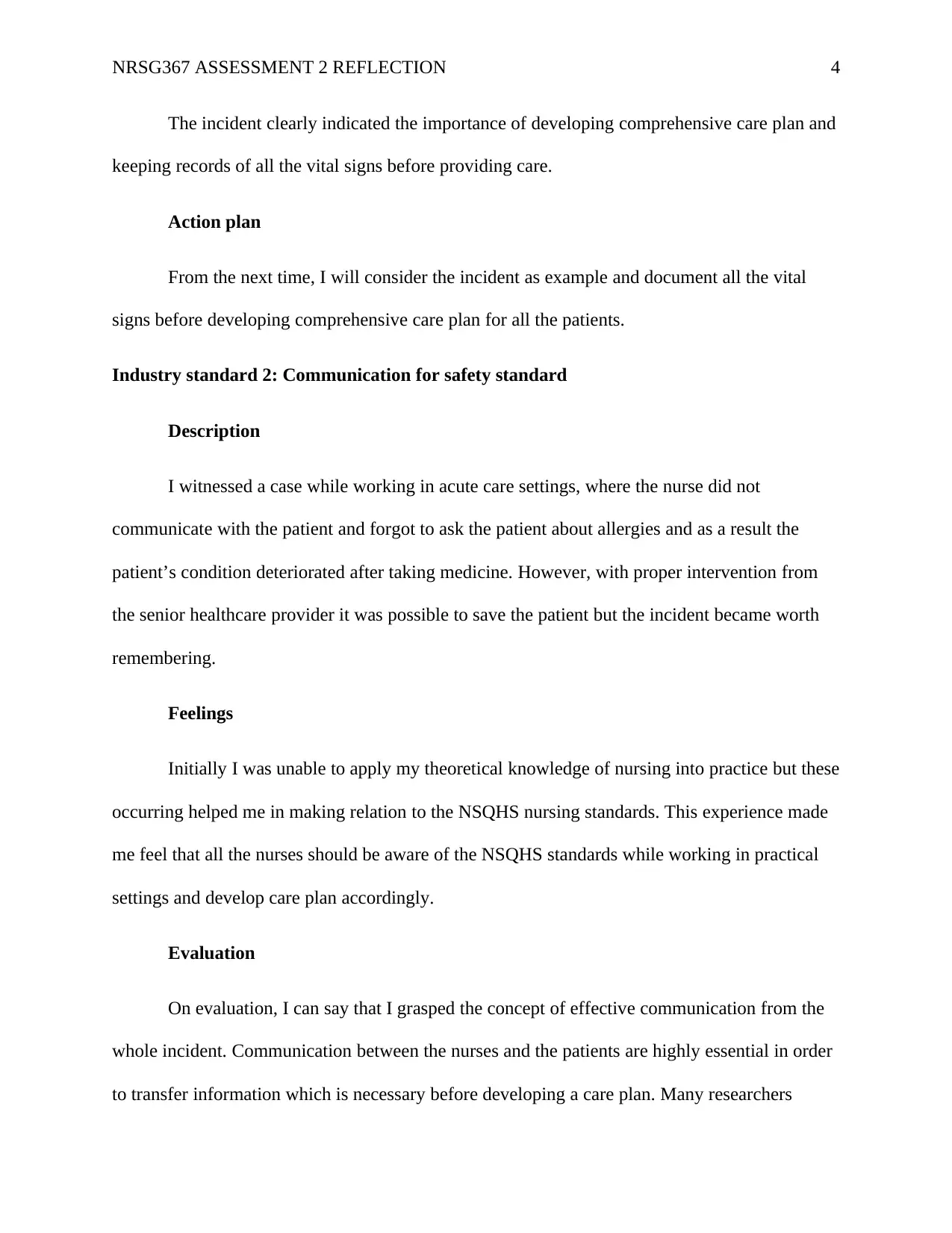
NRSG367 ASSESSMENT 2 REFLECTION 4
The incident clearly indicated the importance of developing comprehensive care plan and
keeping records of all the vital signs before providing care.
Action plan
From the next time, I will consider the incident as example and document all the vital
signs before developing comprehensive care plan for all the patients.
Industry standard 2: Communication for safety standard
Description
I witnessed a case while working in acute care settings, where the nurse did not
communicate with the patient and forgot to ask the patient about allergies and as a result the
patient’s condition deteriorated after taking medicine. However, with proper intervention from
the senior healthcare provider it was possible to save the patient but the incident became worth
remembering.
Feelings
Initially I was unable to apply my theoretical knowledge of nursing into practice but these
occurring helped me in making relation to the NSQHS nursing standards. This experience made
me feel that all the nurses should be aware of the NSQHS standards while working in practical
settings and develop care plan accordingly.
Evaluation
On evaluation, I can say that I grasped the concept of effective communication from the
whole incident. Communication between the nurses and the patients are highly essential in order
to transfer information which is necessary before developing a care plan. Many researchers
The incident clearly indicated the importance of developing comprehensive care plan and
keeping records of all the vital signs before providing care.
Action plan
From the next time, I will consider the incident as example and document all the vital
signs before developing comprehensive care plan for all the patients.
Industry standard 2: Communication for safety standard
Description
I witnessed a case while working in acute care settings, where the nurse did not
communicate with the patient and forgot to ask the patient about allergies and as a result the
patient’s condition deteriorated after taking medicine. However, with proper intervention from
the senior healthcare provider it was possible to save the patient but the incident became worth
remembering.
Feelings
Initially I was unable to apply my theoretical knowledge of nursing into practice but these
occurring helped me in making relation to the NSQHS nursing standards. This experience made
me feel that all the nurses should be aware of the NSQHS standards while working in practical
settings and develop care plan accordingly.
Evaluation
On evaluation, I can say that I grasped the concept of effective communication from the
whole incident. Communication between the nurses and the patients are highly essential in order
to transfer information which is necessary before developing a care plan. Many researchers
Paraphrase This Document
Need a fresh take? Get an instant paraphrase of this document with our AI Paraphraser
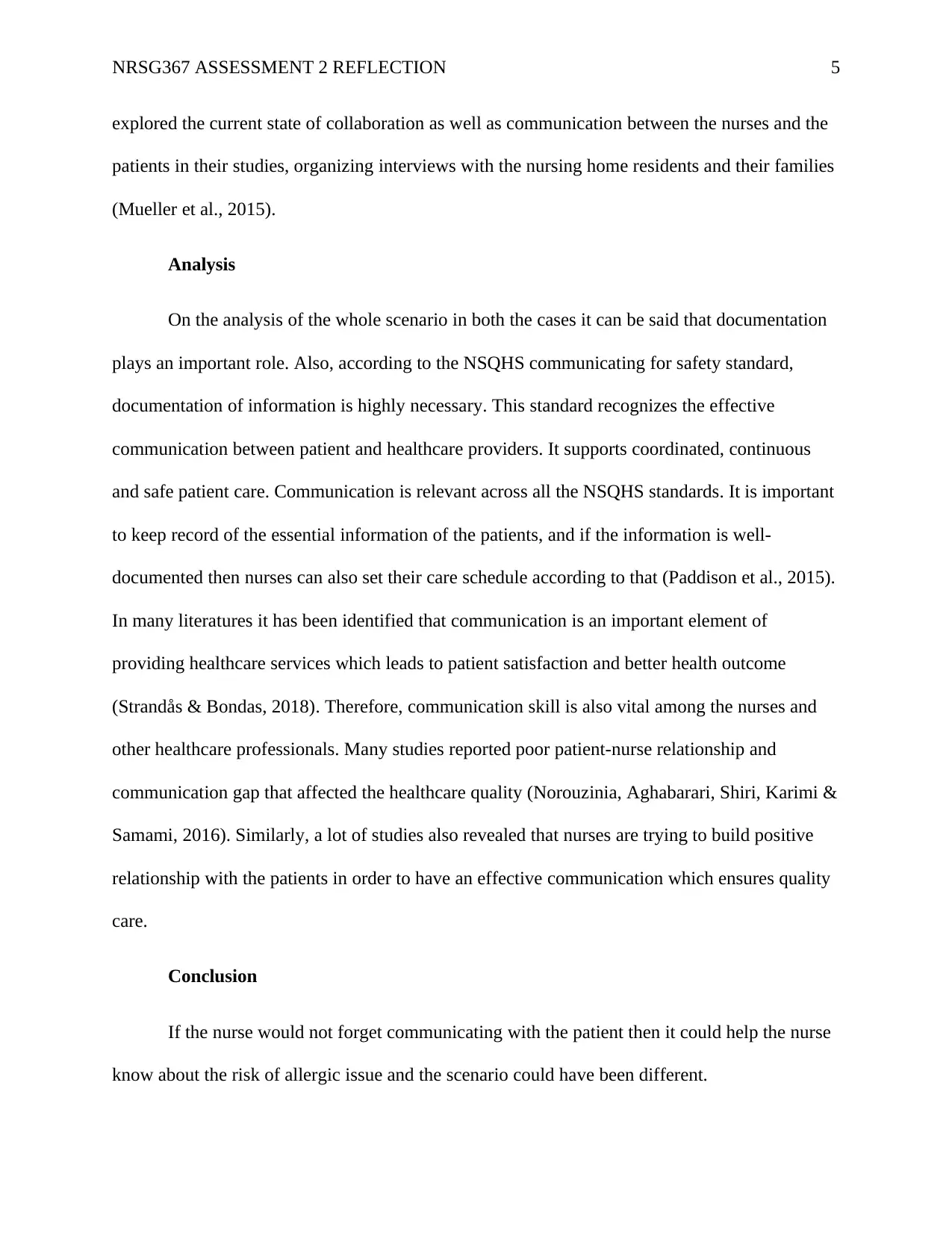
NRSG367 ASSESSMENT 2 REFLECTION 5
explored the current state of collaboration as well as communication between the nurses and the
patients in their studies, organizing interviews with the nursing home residents and their families
(Mueller et al., 2015).
Analysis
On the analysis of the whole scenario in both the cases it can be said that documentation
plays an important role. Also, according to the NSQHS communicating for safety standard,
documentation of information is highly necessary. This standard recognizes the effective
communication between patient and healthcare providers. It supports coordinated, continuous
and safe patient care. Communication is relevant across all the NSQHS standards. It is important
to keep record of the essential information of the patients, and if the information is well-
documented then nurses can also set their care schedule according to that (Paddison et al., 2015).
In many literatures it has been identified that communication is an important element of
providing healthcare services which leads to patient satisfaction and better health outcome
(Strandås & Bondas, 2018). Therefore, communication skill is also vital among the nurses and
other healthcare professionals. Many studies reported poor patient-nurse relationship and
communication gap that affected the healthcare quality (Norouzinia, Aghabarari, Shiri, Karimi &
Samami, 2016). Similarly, a lot of studies also revealed that nurses are trying to build positive
relationship with the patients in order to have an effective communication which ensures quality
care.
Conclusion
If the nurse would not forget communicating with the patient then it could help the nurse
know about the risk of allergic issue and the scenario could have been different.
explored the current state of collaboration as well as communication between the nurses and the
patients in their studies, organizing interviews with the nursing home residents and their families
(Mueller et al., 2015).
Analysis
On the analysis of the whole scenario in both the cases it can be said that documentation
plays an important role. Also, according to the NSQHS communicating for safety standard,
documentation of information is highly necessary. This standard recognizes the effective
communication between patient and healthcare providers. It supports coordinated, continuous
and safe patient care. Communication is relevant across all the NSQHS standards. It is important
to keep record of the essential information of the patients, and if the information is well-
documented then nurses can also set their care schedule according to that (Paddison et al., 2015).
In many literatures it has been identified that communication is an important element of
providing healthcare services which leads to patient satisfaction and better health outcome
(Strandås & Bondas, 2018). Therefore, communication skill is also vital among the nurses and
other healthcare professionals. Many studies reported poor patient-nurse relationship and
communication gap that affected the healthcare quality (Norouzinia, Aghabarari, Shiri, Karimi &
Samami, 2016). Similarly, a lot of studies also revealed that nurses are trying to build positive
relationship with the patients in order to have an effective communication which ensures quality
care.
Conclusion
If the nurse would not forget communicating with the patient then it could help the nurse
know about the risk of allergic issue and the scenario could have been different.
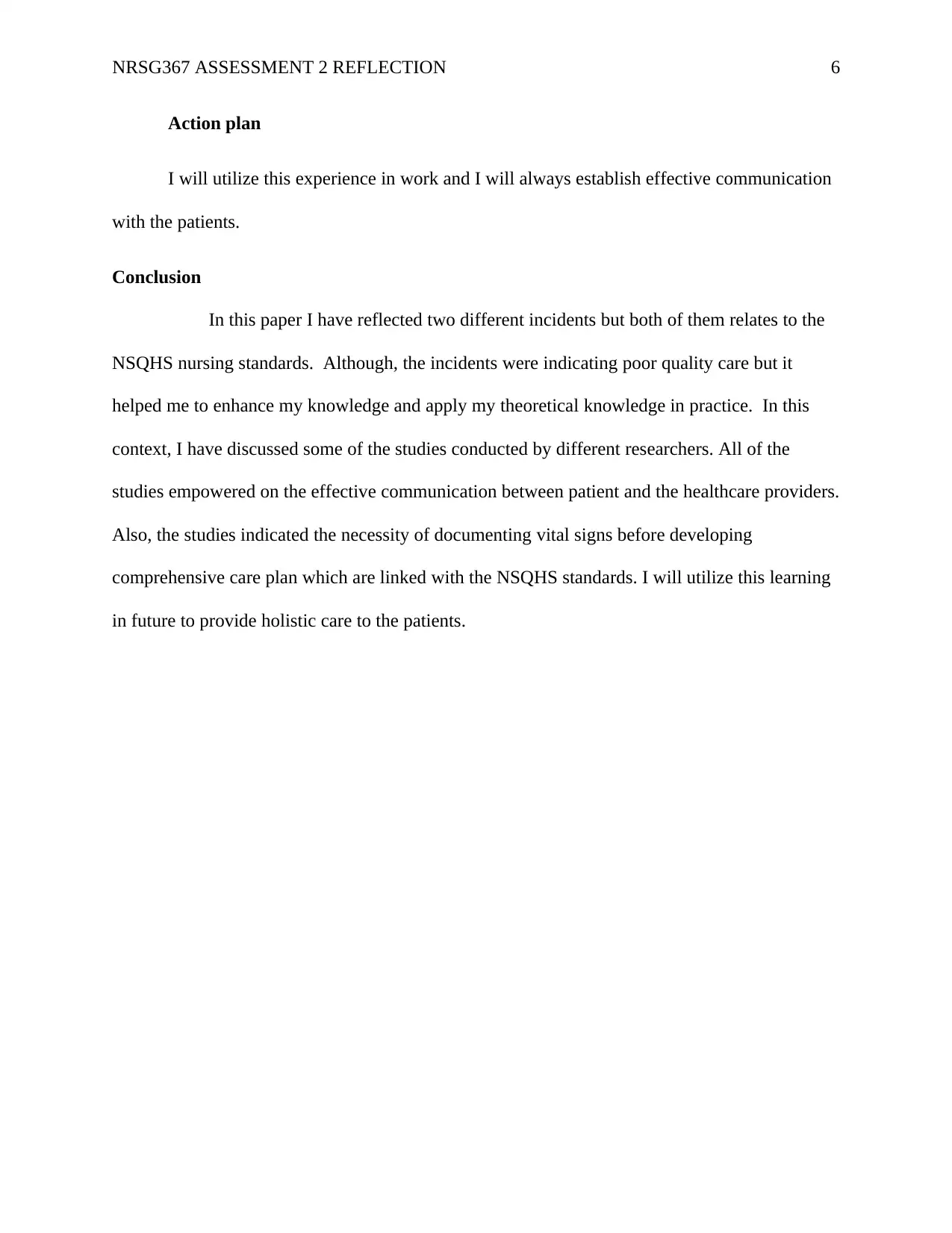
NRSG367 ASSESSMENT 2 REFLECTION 6
Action plan
I will utilize this experience in work and I will always establish effective communication
with the patients.
Conclusion
In this paper I have reflected two different incidents but both of them relates to the
NSQHS nursing standards. Although, the incidents were indicating poor quality care but it
helped me to enhance my knowledge and apply my theoretical knowledge in practice. In this
context, I have discussed some of the studies conducted by different researchers. All of the
studies empowered on the effective communication between patient and the healthcare providers.
Also, the studies indicated the necessity of documenting vital signs before developing
comprehensive care plan which are linked with the NSQHS standards. I will utilize this learning
in future to provide holistic care to the patients.
Action plan
I will utilize this experience in work and I will always establish effective communication
with the patients.
Conclusion
In this paper I have reflected two different incidents but both of them relates to the
NSQHS nursing standards. Although, the incidents were indicating poor quality care but it
helped me to enhance my knowledge and apply my theoretical knowledge in practice. In this
context, I have discussed some of the studies conducted by different researchers. All of the
studies empowered on the effective communication between patient and the healthcare providers.
Also, the studies indicated the necessity of documenting vital signs before developing
comprehensive care plan which are linked with the NSQHS standards. I will utilize this learning
in future to provide holistic care to the patients.
⊘ This is a preview!⊘
Do you want full access?
Subscribe today to unlock all pages.

Trusted by 1+ million students worldwide
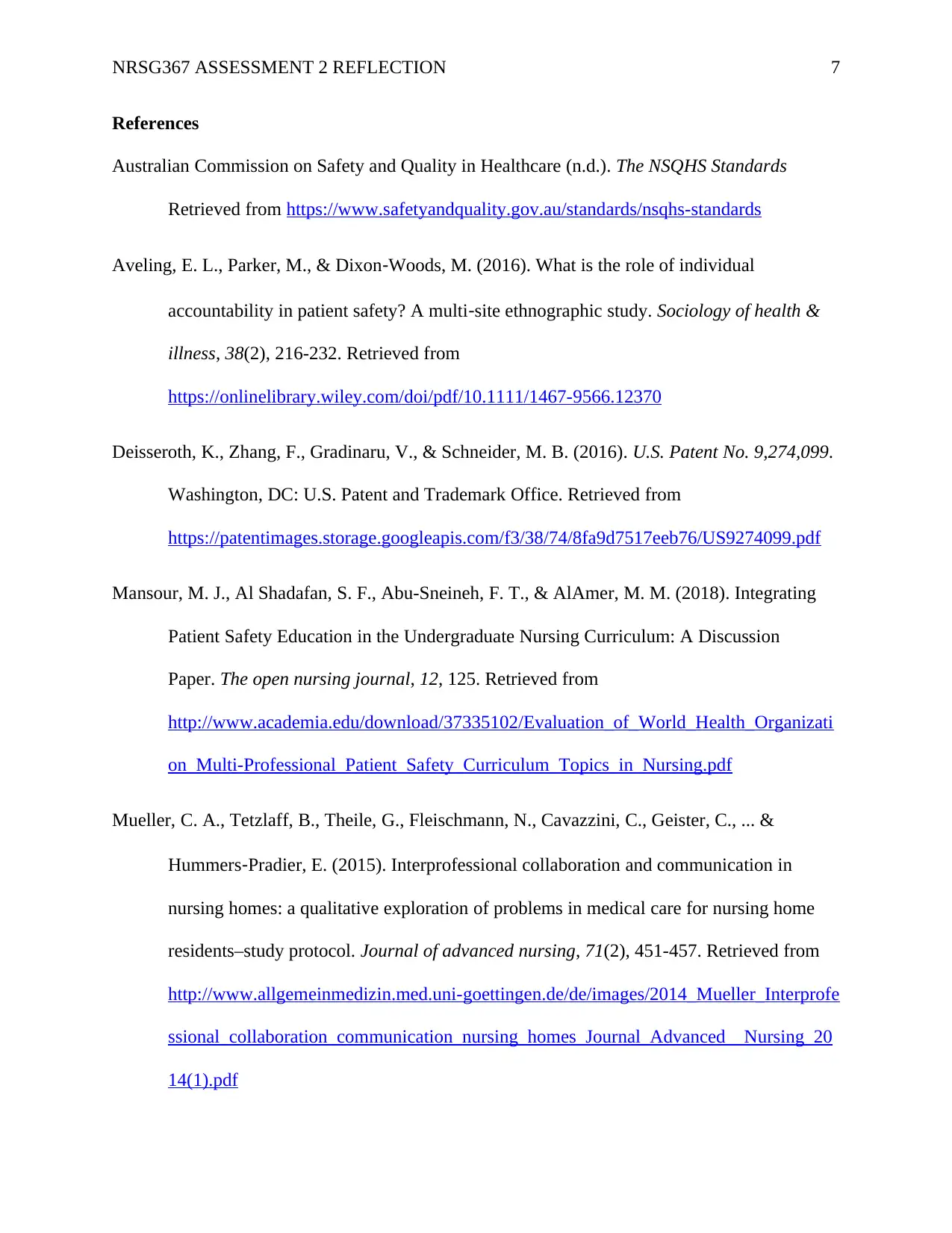
NRSG367 ASSESSMENT 2 REFLECTION 7
References
Australian Commission on Safety and Quality in Healthcare (n.d.). The NSQHS Standards
Retrieved from https://www.safetyandquality.gov.au/standards/nsqhs-standards
Aveling, E. L., Parker, M., & Dixon‐Woods, M. (2016). What is the role of individual
accountability in patient safety? A multi‐site ethnographic study. Sociology of health &
illness, 38(2), 216-232. Retrieved from
https://onlinelibrary.wiley.com/doi/pdf/10.1111/1467-9566.12370
Deisseroth, K., Zhang, F., Gradinaru, V., & Schneider, M. B. (2016). U.S. Patent No. 9,274,099.
Washington, DC: U.S. Patent and Trademark Office. Retrieved from
https://patentimages.storage.googleapis.com/f3/38/74/8fa9d7517eeb76/US9274099.pdf
Mansour, M. J., Al Shadafan, S. F., Abu-Sneineh, F. T., & AlAmer, M. M. (2018). Integrating
Patient Safety Education in the Undergraduate Nursing Curriculum: A Discussion
Paper. The open nursing journal, 12, 125. Retrieved from
http://www.academia.edu/download/37335102/Evaluation_of_World_Health_Organizati
on_Multi-Professional_Patient_Safety_Curriculum_Topics_in_Nursing.pdf
Mueller, C. A., Tetzlaff, B., Theile, G., Fleischmann, N., Cavazzini, C., Geister, C., ... &
Hummers‐Pradier, E. (2015). Interprofessional collaboration and communication in
nursing homes: a qualitative exploration of problems in medical care for nursing home
residents–study protocol. Journal of advanced nursing, 71(2), 451-457. Retrieved from
http://www.allgemeinmedizin.med.uni-goettingen.de/de/images/2014_Mueller_Interprofe
ssional_collaboration_communication_nursing_homes_Journal_Advanced__Nursing_20
14(1).pdf
References
Australian Commission on Safety and Quality in Healthcare (n.d.). The NSQHS Standards
Retrieved from https://www.safetyandquality.gov.au/standards/nsqhs-standards
Aveling, E. L., Parker, M., & Dixon‐Woods, M. (2016). What is the role of individual
accountability in patient safety? A multi‐site ethnographic study. Sociology of health &
illness, 38(2), 216-232. Retrieved from
https://onlinelibrary.wiley.com/doi/pdf/10.1111/1467-9566.12370
Deisseroth, K., Zhang, F., Gradinaru, V., & Schneider, M. B. (2016). U.S. Patent No. 9,274,099.
Washington, DC: U.S. Patent and Trademark Office. Retrieved from
https://patentimages.storage.googleapis.com/f3/38/74/8fa9d7517eeb76/US9274099.pdf
Mansour, M. J., Al Shadafan, S. F., Abu-Sneineh, F. T., & AlAmer, M. M. (2018). Integrating
Patient Safety Education in the Undergraduate Nursing Curriculum: A Discussion
Paper. The open nursing journal, 12, 125. Retrieved from
http://www.academia.edu/download/37335102/Evaluation_of_World_Health_Organizati
on_Multi-Professional_Patient_Safety_Curriculum_Topics_in_Nursing.pdf
Mueller, C. A., Tetzlaff, B., Theile, G., Fleischmann, N., Cavazzini, C., Geister, C., ... &
Hummers‐Pradier, E. (2015). Interprofessional collaboration and communication in
nursing homes: a qualitative exploration of problems in medical care for nursing home
residents–study protocol. Journal of advanced nursing, 71(2), 451-457. Retrieved from
http://www.allgemeinmedizin.med.uni-goettingen.de/de/images/2014_Mueller_Interprofe
ssional_collaboration_communication_nursing_homes_Journal_Advanced__Nursing_20
14(1).pdf
Paraphrase This Document
Need a fresh take? Get an instant paraphrase of this document with our AI Paraphraser
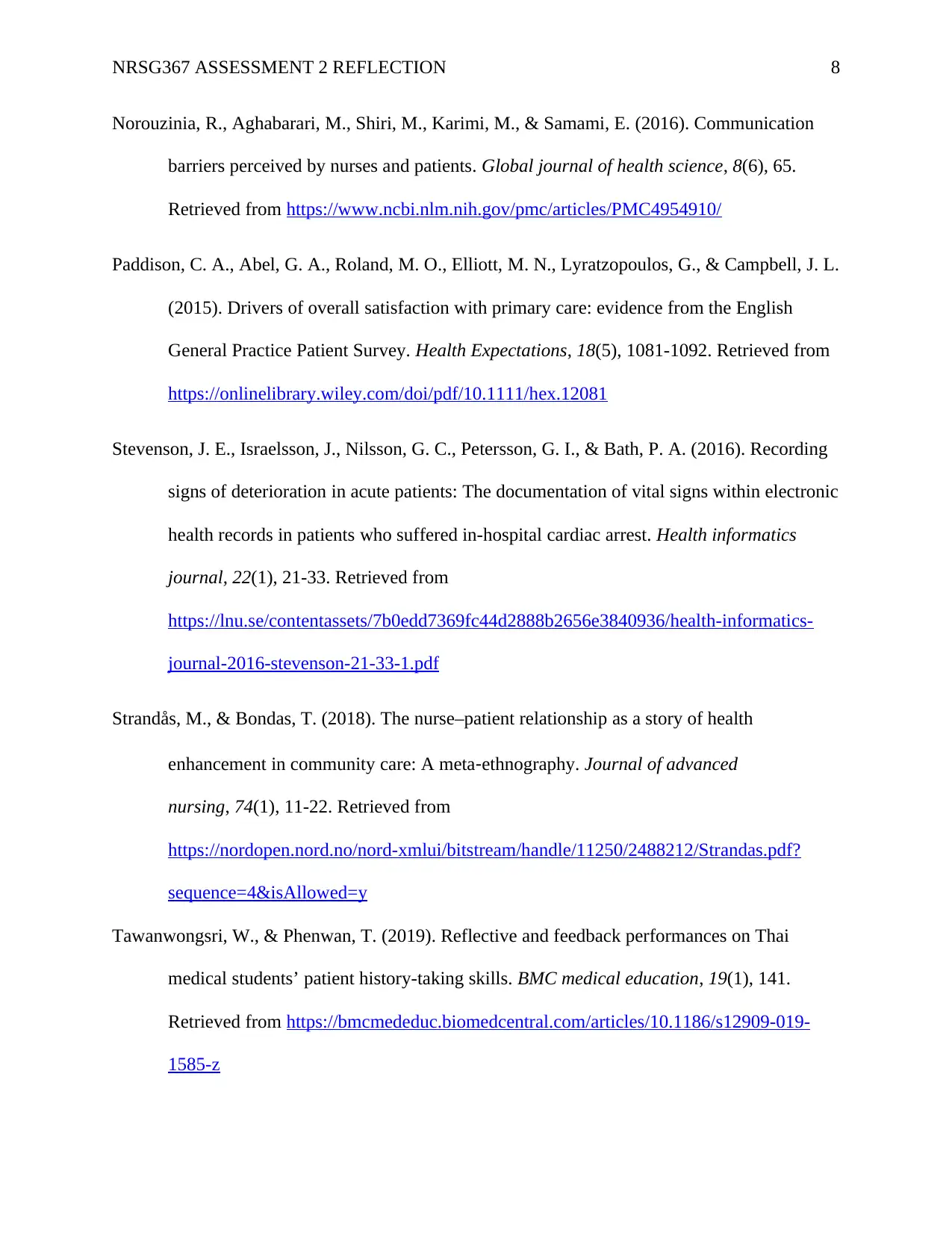
NRSG367 ASSESSMENT 2 REFLECTION 8
Norouzinia, R., Aghabarari, M., Shiri, M., Karimi, M., & Samami, E. (2016). Communication
barriers perceived by nurses and patients. Global journal of health science, 8(6), 65.
Retrieved from https://www.ncbi.nlm.nih.gov/pmc/articles/PMC4954910/
Paddison, C. A., Abel, G. A., Roland, M. O., Elliott, M. N., Lyratzopoulos, G., & Campbell, J. L.
(2015). Drivers of overall satisfaction with primary care: evidence from the English
General Practice Patient Survey. Health Expectations, 18(5), 1081-1092. Retrieved from
https://onlinelibrary.wiley.com/doi/pdf/10.1111/hex.12081
Stevenson, J. E., Israelsson, J., Nilsson, G. C., Petersson, G. I., & Bath, P. A. (2016). Recording
signs of deterioration in acute patients: The documentation of vital signs within electronic
health records in patients who suffered in-hospital cardiac arrest. Health informatics
journal, 22(1), 21-33. Retrieved from
https://lnu.se/contentassets/7b0edd7369fc44d2888b2656e3840936/health-informatics-
journal-2016-stevenson-21-33-1.pdf
Strandås, M., & Bondas, T. (2018). The nurse–patient relationship as a story of health
enhancement in community care: A meta‐ethnography. Journal of advanced
nursing, 74(1), 11-22. Retrieved from
https://nordopen.nord.no/nord-xmlui/bitstream/handle/11250/2488212/Strandas.pdf?
sequence=4&isAllowed=y
Tawanwongsri, W., & Phenwan, T. (2019). Reflective and feedback performances on Thai
medical students’ patient history-taking skills. BMC medical education, 19(1), 141.
Retrieved from https://bmcmededuc.biomedcentral.com/articles/10.1186/s12909-019-
1585-z
Norouzinia, R., Aghabarari, M., Shiri, M., Karimi, M., & Samami, E. (2016). Communication
barriers perceived by nurses and patients. Global journal of health science, 8(6), 65.
Retrieved from https://www.ncbi.nlm.nih.gov/pmc/articles/PMC4954910/
Paddison, C. A., Abel, G. A., Roland, M. O., Elliott, M. N., Lyratzopoulos, G., & Campbell, J. L.
(2015). Drivers of overall satisfaction with primary care: evidence from the English
General Practice Patient Survey. Health Expectations, 18(5), 1081-1092. Retrieved from
https://onlinelibrary.wiley.com/doi/pdf/10.1111/hex.12081
Stevenson, J. E., Israelsson, J., Nilsson, G. C., Petersson, G. I., & Bath, P. A. (2016). Recording
signs of deterioration in acute patients: The documentation of vital signs within electronic
health records in patients who suffered in-hospital cardiac arrest. Health informatics
journal, 22(1), 21-33. Retrieved from
https://lnu.se/contentassets/7b0edd7369fc44d2888b2656e3840936/health-informatics-
journal-2016-stevenson-21-33-1.pdf
Strandås, M., & Bondas, T. (2018). The nurse–patient relationship as a story of health
enhancement in community care: A meta‐ethnography. Journal of advanced
nursing, 74(1), 11-22. Retrieved from
https://nordopen.nord.no/nord-xmlui/bitstream/handle/11250/2488212/Strandas.pdf?
sequence=4&isAllowed=y
Tawanwongsri, W., & Phenwan, T. (2019). Reflective and feedback performances on Thai
medical students’ patient history-taking skills. BMC medical education, 19(1), 141.
Retrieved from https://bmcmededuc.biomedcentral.com/articles/10.1186/s12909-019-
1585-z
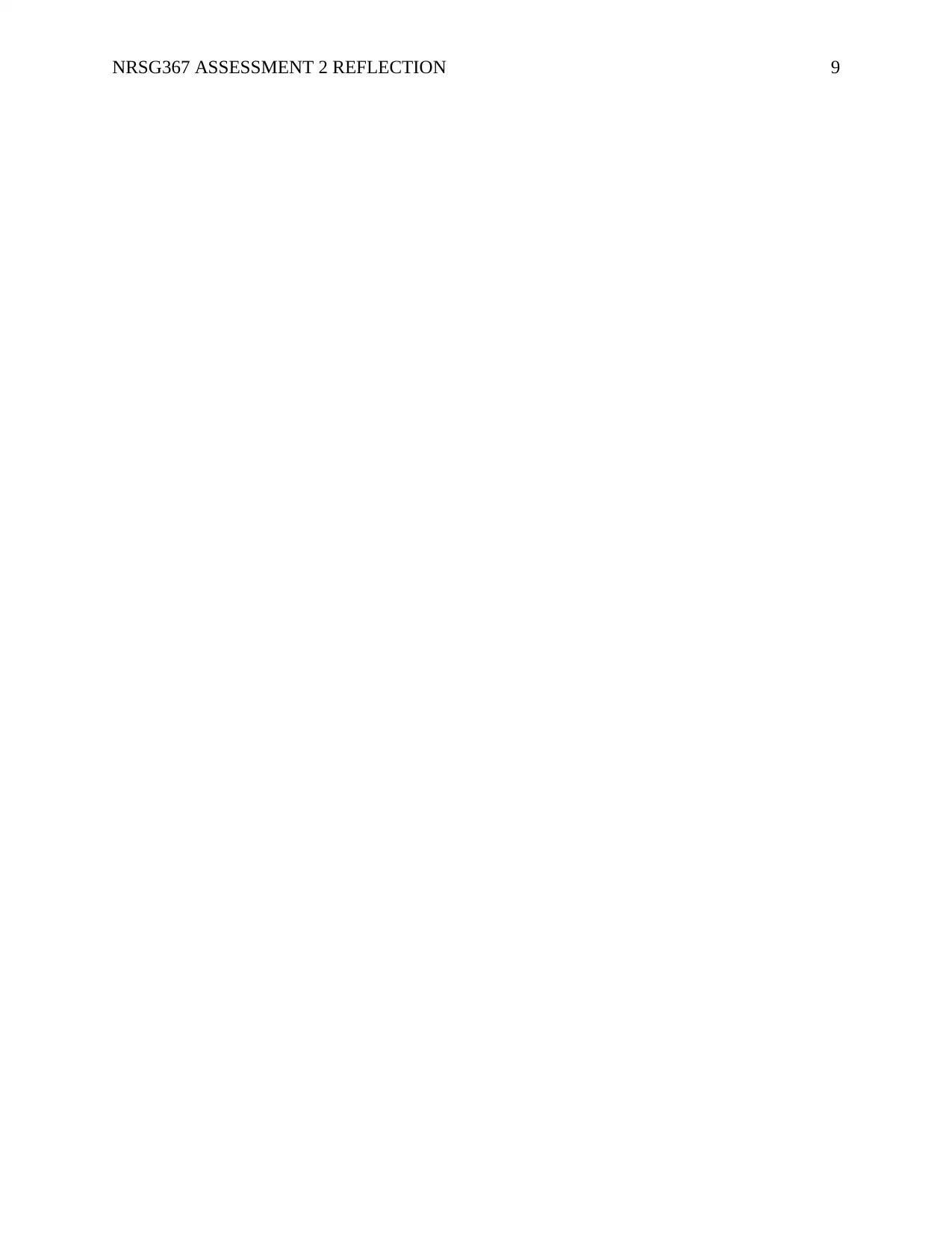
NRSG367 ASSESSMENT 2 REFLECTION 9
⊘ This is a preview!⊘
Do you want full access?
Subscribe today to unlock all pages.

Trusted by 1+ million students worldwide
1 out of 9
Related Documents
Your All-in-One AI-Powered Toolkit for Academic Success.
+13062052269
info@desklib.com
Available 24*7 on WhatsApp / Email
![[object Object]](/_next/static/media/star-bottom.7253800d.svg)
Unlock your academic potential
Copyright © 2020–2025 A2Z Services. All Rights Reserved. Developed and managed by ZUCOL.





